Vytis
The Coat of Arms of Lithuania is called Vytis (the Pursuer). It is one of the oldest Coat of Arms in Europe.
The modern heraldic shield adopted in September, 1991 features an armored knight on a silver (white) horse on the red field. The man is holding a silver sword in his right hand above his head. A blue shield hangs on the left shoulder of the charging knight with a double gold (yellow) cross on it. The horse saddle, straps, and belts are blue. The hilt of the sword and the fastening of the sheath, the knight's spurs, the curb bits of the bridle, the horseshoes, as well as the decoration of the harness, are gold.

 
According to some sources the knight on horseback was mentioned in some early chronicles, but the charging knight is known to have been first used as the state emblem in 1366 on the seal of the Grand Duke of Lithuania, Algirdas. Earliest coins featuring Vytis come also from the second half of the 14th century. The other side of these coins depicts Columns of Gediminas. The emblem was handed down through the generations, from Algirdas to his son, Grand Duke Jogaila, then to Grand Duke Vytautas and others. In the 14th century, the knight was featured on a heraldic shield, first on Jogaila's seal in 1386 or 1387, and also on the seal of Vytautas in 1401. As early as the 15th century, the heraldic knight became the Coat of Arms of the Grand Duchy of Lithuania and of its central part - the Duchy of Vilnius. It is known that at the Battle of Grunwald in 1410, a major victory of the united Polish-Lithuanian army against the Teutonic Knights, thirty Lithuanian regiments out of the total forty were flying the banner of the Vytis.
 
  
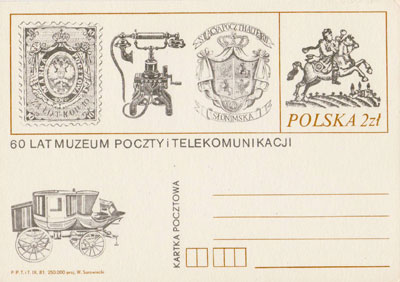
  
   
  
  
  
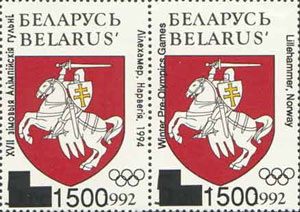 

 
At first, the charging knight was depicted riding to left or right, and sometimes holding a lance. But by the first half of the 15th century, he is always shown riding to the left with a sword in his raised hand and a shield in the left hand (if he rode to the right, the shield would be concealed by the rider). During the 15th century, the colors of the seal became uniform: a white (silver) charging knight on a red field of the heraldic shield. The shield was blue with a double (gold) cross. The double cross has no explanation and its meaning is unknown. It was found on Jogaila's seal for the first time. The cross is constructed in such a way that all six ends are equal in length.
The Renaissance introduced minor stylistic changes and variations: long feathers waving from the tip of the knight's helm, a long saddle-cloth, the horse tail turned upwards and shaped as nosegay. With these changes the Vytis Coat of Arms remained the State symbol of the Grand Duchy of Lithuania until 1795, when Lithuania was annexed by the Russian Empire. The Vytis was abolished. However, in 1845 tsar Nicholas I confirmed a Coat of Arms for the Vilnius Guberniya that closely resembled the Vytis. At first, the charging knight was interpreted as the ruler of the country. As time passed, he became a knight who is chasing intruders out of his native country. Such an interpretation was especially popular in the 19th century, and the first half of the 20th century, when Lithuania was part of the Russian Empire and sought its independence.
 
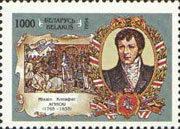 
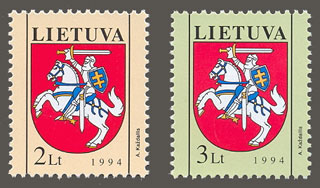
When Lithuania restored its independence in 1918-1920, several artists produced different versions of the Coat of Arms. Almost all versions included a scabbard, which is not found in earliest speciments. A romanticized version by Antanas Žmuidzinavičius became the most popular. The horse appeared to be flying in the air. The gear was very decorative. For example, the saddle blanket was very long and divided into three parts. There was no uniform or official version of the Coat of Arms. To address popular complaints, in 1929 a special commission was set up to analyze the best 16th century specimens of Vytis to design an official state emblem. Mstislav Dobuzhinsky was the chief artist. The commission worked for 5 years, but their version of the Vytis was not officially confirmed.
The Vytis was the state emblem of the Republic of Lithuania until 1940, when the Republic was annexed by the Soviet Union and all national insignia were outlawed. With the collapse of the Soviet Union, the Vytis, together with the Columns of Gediminas and the national flag, became symbols of the independence movement in Lithuania. In 1988, the Vytis was legalized. On March 11, 1990 Lithuania declared its independence and restored all of its pre-war national symbols, including the Vytis. On March 20, 1990 the Supreme Council of Lithuania approved the description of the State's Coat of Arms and determined the principal regulations for its use. The design was based on Juozas Zikaras design that was used on all litas coins in the interwar period. This was to demonstrate that Lithuania was continuing the traditions of the State that existed between 1918-1940. On September 4, 1991, a new design was approved based on recommendations of a special heraldic committee. It abandoned romantic interwar traditions and went back to the times of the Grand Duchy of Lithuania. It re-established the original colors. However, early coins of centas still bear the old Zikaras' design.
In 2004, the Seimas confirmed the new national symbol and the historical flag of Lithuania. It depicts the Coat of Arms on a rectangular red fabric. It did not replace the tri-color national flag of Lithuania. It is used only by official institutions for special occasions and anniversaries. It is currently proposed that a larger version of the Coat of Arms should be adopted. It would have a line from Tautiška giesmė, the national anthem of Lithuania, "Vienybė težydi" (Let Unity Flourish).
The former coat of arms of Belarus - last used 1991 1995 - was very similar to the Vytis, with one difference only - the cross on the shield was a patriarchal cross with arms of uneven length. This symbol is known as the Pahonia.
The Pahonia was used as an official Belarus coat of arms on several occasions, with the first being used from 1366 as the coat of arms of the Grand Duchy of Lithuania as the personal arms of Algirdas, the Grand Duke of Lithuania. The arms continued to be used until Belarus and Lithuania was annexed by the Russian Empire in 1795, though the arms was incorporated into the Imperial coat of arms.

\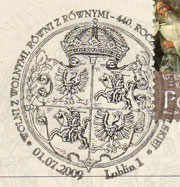 



|